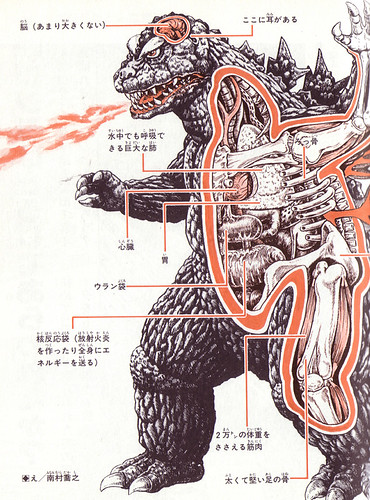That’s the title of a post at Darren Nash’s Tetrapods blog (which, as a point of information, has relocated to Scientific American’s blogoverse). Here’s the opening paragraph:
To begin with, let’s get things straight and admit up front that Godzilla is not a real animal, nor was it ever. It’s an unfeasibly big late-surviving dinosaur (belonging to the hypothetical taxon Godzillasaurus, according to some), mutated by radiation, with a radioactive heart. Godzilla is virtually impervious to other gigantic monsters, and also to robots, artillery, laser blasts, lava and fire. Not real. Sorry about that. But by posing questions about fictional entities we can still learn stuff, and you may be surprised to learn that Godzilla has, on occasion, been discussed semi-seriously by various biologists and palaeontologists. Ok, that won’t surprise you if you already know anything about Godzilla, but what the hey.
Godzilla may not be real, but it’s a useful prod to thought.
For example, there is this:
In 2000, a peer-reviewed technical paper on the biology of TriStar’s GINO [Godzilla In Name Only] was published in Mathematical Geology by zoologist Per Christiansen. Per is well known for his work on mathematical scaling in dinosaurs, proboscideans, cats and other tetrapods ... Providing a wealth of speculations and inferences about GINO’s locomotor abilities, biomechanics and physiology, the article mostly critiques the view that the new Godzilla created for TriStar’s 1998 movie is more realistic, from a biological perspective, than the Japanese original (Christiansen 2000). To cut a long story short, Per concluded that TriStar’s GINO violated a number of biomechanical rules; in short, the creature is biologically implausible. Not exactly a surprise. His comment that the real Godzilla “is actually much more plausible from a biological perspective” (p. 239) is mostly based on the real Godzilla’s massive columnar legs and walking (rather than sprinting) gait.
And this:
Based on the conclusions of Japanese palaeontologist Dr Yamane, we ‘know’ that the original Godzilla from the 1954 movie was a dinosaur, and – according to Carpenter (1998) – it was clearly a theropod. Yes, this is Ken Carpenter, the palaeontologist best known for his work on the armoured ankylosaurs. By inferring certain morphological details, Carpenter concluded that Godzilla must have been a gigantic neoceratosaur related to ceratosaurids and abelisaurs ... In part this idea comes from the shared derived character of bony scutes growing along the dorsal midline: present in both Godzilla and ceratosaurids, these aren’t present in other theropods and were therefore interpreted as a synapomorphy.
There’s a lot more of that kind of stuff, plus scads of pictures. Such as this one at Frederick Barr’s Flickr site:

One major issue with Godzilla would be reproduction. Wouldn't all the positional negotiations between him and the Mrs. create enough mechanical stresses to break their bones and kill them?
ReplyDelete